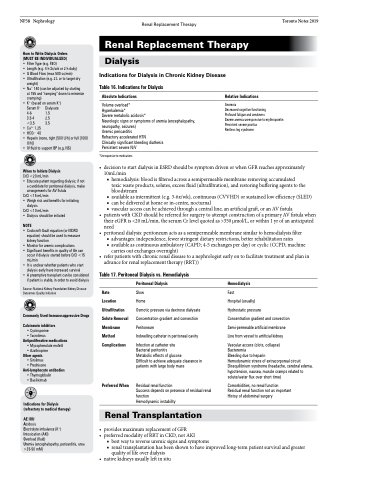Page 738 - TNFlipTest
P. 738
NP38 Nephrology
Renal Replacement Therapy
Toronto Notes 2019
How to Write Dialysis Orders (MUST BE INDIVIDUALIZED)
• Filter Type (e.g. F8O)
• Length (e.g. 4 h 3x/wk or 2 h daily)
• Q Blood Flow (max 500 cc/min)
• Ultrafiltration (e.g. 2 L or to target dry weight)
• Na+ 140 (can be adjusted by starting at 155 and “ramping” down to minimize cramping)
• K+ (based on serum K+)
Renal Replacement Therapy
Dialysis
Indications for Dialysis in Chronic Kidney Disease
Dialysate 1.5
2.5
3.5
• Ca2+ 1.25
• HCO3– 40
• Heparin (none, tight [500 U/h] or full [1000
U/h])
• IV fluid to support BP (e.g. NS)
When to Initiate Dialysis
CrCl <20 mL/min
• Educate patient regarding dialysis; if not
a candidate for peritoneal dialysis, make
arrangements for AV fistula
CrCl <15 mL/min
• Weigh risk and benefits for initiating
dialysis
CrCl <10 mL/min
• Dialysis should be initiated
NOTE
• Cockcroft-Gault equation (or MDRD equation) should be used to measure kidney function
• Monitor for uremic complications
• Significant benefits in quality of life can
occur if dialysis started before CrCl <15
mL/min
• It is unclear whether patients who start
dialysis early have increased survival
• A preemptive transplant can be considered if patient is stable, in order to avoid dialysis
Source: National Kidney Foundation Kidney Disease Outcomes Quality Initiative
Commonly Used Immunosuppressive Drugs
Calcineurin inhibitors
• Cyclosporine
• Tacrolimus
Antiproliferative medications
• Mycophenolate mofetil
• Azathioprine
Other agents
• Sirolimus
• Prednisone
Anti-lymphocyte antibodies
• Thymoglobulin • Basiliximab
Indications for Dialysis (refractory to medical therapy)
AE IOU
Acidosis
Electrolyte imbalance (K+)
Intoxication (AKI)
Overload (fluid)
Uremia (encephalopathy, pericarditis, urea >35-50 mM)
Table 16. Indications for Dialysis
Absolute Indications
Volume overload*
Hyperkalemia*
Severe metabolic acidosis*
Neurologic signs or symptoms of uremia (encephalopathy, neuropathy, seizures)
Uremic pericarditis
Refractory accelerated HTN
Clinically significant bleeding diathesis
Persistent severe N/V
*Unresponsive to medications
Relative Indications
Anorexia
Decreased cognitive functioning
Profound fatigue and weakness
Severe anemia unresponsive to erythropoietin Persistent severe pruritus
Restless leg syndrome
Serum K+ 4-6
3.5-4 <3.5
• decisiontostartdialysisinESRDshouldbesymptomdrivenorwhenGFRreachesapproximately 10mL/min
■ hemodialysis: blood is filtered across a semipermeable membrane removing accumulated toxic waste products, solutes, excess fluid (ultrafiltration), and restoring buffering agents to the bloodstream
■ available as intermittent (e.g. 3-6x/wk), continuous (CVVHD) or sustained low efficiency (SLED)
■ can be delivered at home or in-centre, nocturnal
■ vascular access can be achieved through a central line, an artificial graft, or an AV fistula
• patients with CKD should be referred for surgery to attempt construction of a primary AV fistula when their eGFR is <20 mL/min, the serum Cr level quoted as >350 μmol/L, or within 1 yr of an anticipated need
• peritonealdialysis:peritoneumactsasasemipermeablemembranesimilartohemodialysisfilter
■ advantages: independence, fewer stringent dietary restrictions, better rehabilitation rates
■ available as continuous ambulatory (CAPD; 4-5 exchanges per day) or cyclic (CCPD; machine
carries out exchanges overnight)
• referpatientswithchronicrenaldiseasetoanephrologistearlyontofacilitatetreatmentandplanin
advance for renal replacement therapy (RRT))
Table 17. Peritoneal Dialysis vs. Hemodialysis
Rate
Location Ultrafiltration Solute Removal Membrane Method Complications
Preferred When
Peritoneal Dialysis
Slow
Home
Osmotic pressure via dextrose dialysate
Concentration gradient and convection
Peritoneum
Indwelling catheter in peritoneal cavity
Infection at catheter site
Bacterial peritonitis
Metabolic effects of glucose
Difficult to achieve adequate clearance in patients with large body mass
Residual renal function
Success depends on presence of residual renal function
Hemodynamic instability
Hemodialysis
Fast
Hospital (usually)
Hydrostatic pressure
Concentration gradient and convection
Semi-permeable artificial membrane
Line from vessel to artificial kidney
Vascular access (clots, collapse)
Bacteremia
Bleeding due to heparin
Hemodynamic stress of extracorporeal circuit Disequilibrium syndrome (headache, cerebral edema, hypotension, nausea, muscle cramps related to solute/water flux over short time)
Comorbidities, no renal function Residual renal function not as important Histoy of abdominal surgery
Renal Transplantation
• providesmaximumreplacementofGFR
• preferredmodalityofRRTinCKD,notAKI
■ best way to reverse uremic signs and symptoms
■ renal transplantation has been shown to have improved long-term patient survival and greater
quality of life over dialysis
• nativekidneysusuallyleftinsitu


